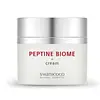What's inside
What's inside
 Key Ingredients
Key Ingredients

 Benefits
Benefits

 Concerns
Concerns

 Ingredients Side-by-side
Ingredients Side-by-side

Panax Ginseng Callus Culture Extract
Skin ConditioningAspergillus/Rice Ferment Extract
HumectantGlycerin
HumectantWater
Skin ConditioningCaprylic/Capric Triglyceride
MaskingDipropylene Glycol
HumectantButylene Glycol
HumectantIsohexadecane
EmollientNiacinamide
Smoothing1,2-Hexanediol
Skin ConditioningGlyceryl Stearate
EmollientSynthetic Beeswax
Emulsion StabilisingHydrogenated Polyisobutene
EmollientCetearyl Olivate
Sorbitan Stearate
EmulsifyingPropanediol
SolventSorbitan Olivate
EmulsifyingSodium Polyacryloyldimethyl Taurate
Emulsion StabilisingHydroxyethyl Acrylate/Sodium Acryloyldimethyl Taurate Copolymer
Emulsion StabilisingSodium Polyacrylate
AbsorbentBiosaccharide Gum-1
HumectantHydrogenated Lecithin
EmulsifyingHydrogenated Polydecene
EmollientEthylhexyl Stearate
EmollientEthylhexylglycerin
Skin ConditioningHydroxyethylcellulose
Emulsion StabilisingAdenosine
Skin ConditioningSorbitan Isostearate
EmulsifyingDisodium EDTA
Trideceth-6
EmulsifyingXanthan Gum
EmulsifyingAmmonium Polyacryloyldimethyl Taurate
Emulsion StabilisingHyaluronic Acid
HumectantHydrolyzed Hyaluronic Acid
HumectantSodium Hyaluronate
HumectantSaccharomyces/Xylinum/Black Tea Ferment
Skin ConditioningBifida Ferment Lysate
Skin ConditioningBacillus Ferment
Skin ConditioningBifida Ferment Filtrate
Skin ConditioningLactococcus Ferment Lysate
Skin ConditioningLactobacillus Ferment
Skin ConditioningLactobacillus/Soybean Ferment Extract
Skin ConditioningSaccharomyces Ferment Filtrate
HumectantYeast
Skin ConditioningFructooligosaccharides
HumectantFructose
HumectantInulin
Skin ConditioningLactose
HumectantMannitol
HumectantMaltodextrin
AbsorbentRaffinose
Skin ConditioningSorbitol
HumectantAcetyl Hexapeptide-8
HumectantAcetyl Octapeptide-3
HumectantAcetyl Tetrapeptide-3
Skin ProtectingTripeptide-3
Skin ConditioningAcetyl Tetrapeptide-9
Skin ConditioningAcetyl Tripeptide-1
Skin ConditioningDipeptide-4
Skin ConditioningHexapeptide-2
BleachingOligopeptide-6
Skin ConditioningAcetyl Tetrapeptide-5
HumectantAvena Sativa Peptide
Skin ConditioningAcetyl Tetrapeptide-2
Skin ConditioningCopper Tripeptide-1
Skin ConditioningDipeptide-2
Skin ConditioningPolypeptide-1
Skin ConditioningHexapeptide-9
Skin ConditioningHexapeptide-11
Skin ConditioningNonapeptide-1
Skin ConditioningPentapeptide-3
Skin ConditioningTripeptide-1
Skin ConditioningTripeptide-2
Skin ConditioningAcetyl Dipeptide-1 Cetyl Ester
Skin ConditioningPalmitoyl Dipeptide-7
Skin ConditioningDipeptide Diaminobutyroyl Benzylamide Diacetate
Skin ConditioningPalmitoyl Tetrapeptide-7
Skin ConditioningPalmitoyl Pentapeptide-4
Skin ConditioningPalmitoyl Tripeptide-5
Skin ConditioningPalmitoyl Hexapeptide-12
Skin ConditioningPalmitoyl Tripeptide-1
Skin ConditioningParfum
MaskingPanax Ginseng Callus Culture Extract, Aspergillus/Rice Ferment Extract, Glycerin, Water, Caprylic/Capric Triglyceride, Dipropylene Glycol, Butylene Glycol, Isohexadecane, Niacinamide, 1,2-Hexanediol, Glyceryl Stearate, Synthetic Beeswax, Hydrogenated Polyisobutene, Cetearyl Olivate, Sorbitan Stearate, Propanediol, Sorbitan Olivate, Sodium Polyacryloyldimethyl Taurate, Hydroxyethyl Acrylate/Sodium Acryloyldimethyl Taurate Copolymer, Sodium Polyacrylate, Biosaccharide Gum-1, Hydrogenated Lecithin, Hydrogenated Polydecene, Ethylhexyl Stearate, Ethylhexylglycerin, Hydroxyethylcellulose, Adenosine, Sorbitan Isostearate, Disodium EDTA, Trideceth-6, Xanthan Gum, Ammonium Polyacryloyldimethyl Taurate, Hyaluronic Acid, Hydrolyzed Hyaluronic Acid, Sodium Hyaluronate, Saccharomyces/Xylinum/Black Tea Ferment, Bifida Ferment Lysate, Bacillus Ferment, Bifida Ferment Filtrate, Lactococcus Ferment Lysate, Lactobacillus Ferment, Lactobacillus/Soybean Ferment Extract, Saccharomyces Ferment Filtrate, Yeast, Fructooligosaccharides, Fructose, Inulin, Lactose, Mannitol, Maltodextrin, Raffinose, Sorbitol, Acetyl Hexapeptide-8, Acetyl Octapeptide-3, Acetyl Tetrapeptide-3, Tripeptide-3, Acetyl Tetrapeptide-9, Acetyl Tripeptide-1, Dipeptide-4, Hexapeptide-2, Oligopeptide-6, Acetyl Tetrapeptide-5, Avena Sativa Peptide, Acetyl Tetrapeptide-2, Copper Tripeptide-1, Dipeptide-2, Polypeptide-1, Hexapeptide-9, Hexapeptide-11, Nonapeptide-1, Pentapeptide-3, Tripeptide-1, Tripeptide-2, Acetyl Dipeptide-1 Cetyl Ester, Palmitoyl Dipeptide-7, Dipeptide Diaminobutyroyl Benzylamide Diacetate, Palmitoyl Tetrapeptide-7, Palmitoyl Pentapeptide-4, Palmitoyl Tripeptide-5, Palmitoyl Hexapeptide-12, Palmitoyl Tripeptide-1, Parfum
Water
Skin ConditioningGlycolic Acid
BufferingPropylene Glycol
HumectantAmmonium Hydroxide
BufferingHydroxyethylcellulose
Emulsion StabilisingCholesterol
EmollientDimethicone
EmollientPetrolatum
EmollientPalmitic Acid
EmollientStearic Acid
CleansingMyristic Acid
CleansingGlyceryl Stearate
EmollientPEG-100 Stearate
PEG-40 Stearate
EmulsifyingIsopropyl Palmitate
EmollientCetyl Alcohol
EmollientSorbitan Stearate
EmulsifyingMagnesium Aluminum Silicate
AbsorbentStearamidopropyl Dimethylamine
EmulsifyingIsostearic Acid
CleansingTetrasodium EDTA
Water, Glycolic Acid, Propylene Glycol, Ammonium Hydroxide, Hydroxyethylcellulose, Cholesterol, Dimethicone, Petrolatum, Palmitic Acid, Stearic Acid, Myristic Acid, Glyceryl Stearate, PEG-100 Stearate, PEG-40 Stearate, Isopropyl Palmitate, Cetyl Alcohol, Sorbitan Stearate, Magnesium Aluminum Silicate, Stearamidopropyl Dimethylamine, Isostearic Acid, Tetrasodium EDTA
 Reviews
Reviews

Ingredients Explained
These ingredients are found in both products.
Ingredients higher up in an ingredient list are typically present in a larger amount.
Glyceryl Stearate is a mix of glycerin and stearic acid.
It is used to stabilize the mixing of water and oil ingredients. By preventing these ingredients from separating, it can help elongate shelf life. It can also help thicken the product's texture.
As an emollient, it helps soften skin and supports barrier-replenishing ingredients.
In cosmetics, Glyceryl Stearate is often made from vegetable oils or synthetically produced.
This ingredient may not be fungal-acne safe
Fun fact: The human body also creates Glyceryl Stearate naturally.
Learn more about Glyceryl StearateHydroxyethylcellulose is used to improve the texture of products. It is created from a chemical reaction involving ethylene oxide and alkali-cellulose. Cellulose is a sugar found in plant cell walls and help give plants structure.
This ingredient helps stabilize products by preventing ingredients from separating. It can also help thicken the texture of a product.
This ingredient can also be found in pill medicines to help our bodies digest other ingredients.
Learn more about HydroxyethylcelluloseSorbitan Stearate comes from sorbitol and stearic acid. Sorbitol is a type of sugar and stearic acid is a fatty acid.
It is used as an emulsifier and helps ingredients stay together by creating water-in-oil emulsions.
This ingredient may not be Malassezia folliculitis, or fungal-acne safe.
Water. It's the most common cosmetic ingredient of all. You'll usually see it at the top of ingredient lists, meaning that it makes up the largest part of the product.
So why is it so popular? Water most often acts as a solvent - this means that it helps dissolve other ingredients into the formulation.
You'll also recognize water as that liquid we all need to stay alive. If you see this, drink a glass of water. Stay hydrated!
Learn more about Water